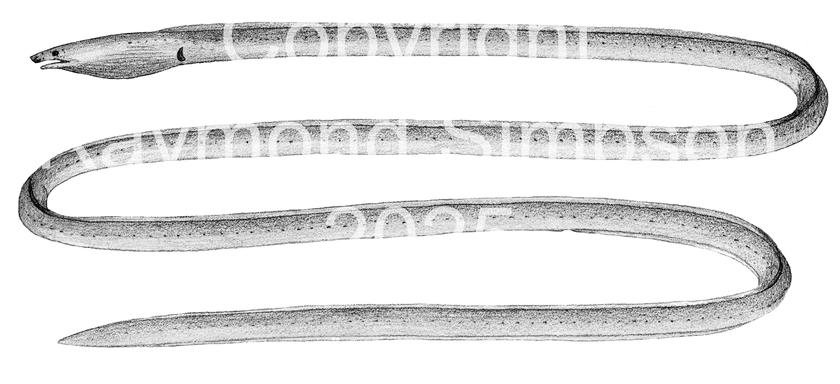
Common Name
String Eel
Year Described
McCosker & Bohlke, 1984
Identification
Vertebrae: 168-176
Body extremely elongate. Cylindrical anteriorly in cross-section but compressed posteriorly. Trunk much longer than tail. Snout pointed laterally, conical dorsally, and overhangs mouth. Underside of snout with a toothed median groove reaching anterior nostrils. Eye small and around middle of jaw. Anterior nostril a simple flush hole (not tubular) with connecting groove. Posterior nostril opens under eye as a small slit. Jaw teeth small and uniserial (8-10 on top and 10-12 on lower jaw). Intermaxillary teeth (4) present. Vomerine teeth in single row of 6-8 teeth. Gill openings crescent-shaped, low on body and converging anteriorly. Gill pouch and body distinctly grooved. Dorsal fin origin well before gill openings, high in height anteriorly, and ending before tail tip. Anal fin present. Pectoral and caudal fins absent. Tail tip hard and pointed. Lateral line complete (161-166 pores). One temporal, 1 interorbital, 5 mandibular, and 2 preopercular pores.
Color
Color in alcohol pale brown with a peppered of dark melanophores.
Size
Maximum size to 33.7cm TL.
Habitat
Found on soft bottoms from 37-72m.
Range
Florida to Guyana and Brazil.
References
Caires, R. A., & J. Fonseca. 2010. The first record of the string eel Gordiichthys leibyi (Anguilliformes: Ophichthidae) in the western South Atlantic. Marine Biodiversity Records, 3, e9.
McCosker, J. E., & J. E. Böhlke. 1984. A review of the snake eel genera Gordiichthys and Ethadophis, with descriptions of new species and comments on related Atlantic bascanichthyins (Pisces: Ophichthidae). Proceedings of the Academy of Natural Sciences of Philadelphia, 32-44.
Other Notes
The three very slender Gordiichthys can be best separated by lateral pore and vertebral counts (G. ergodes also has tubular nostrils). G. randalli is less slender and has biserial vomerine teeth.